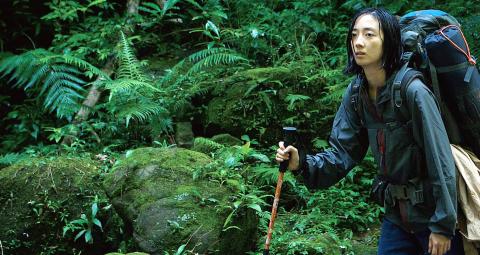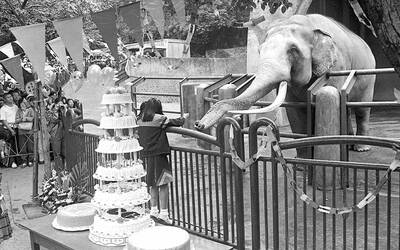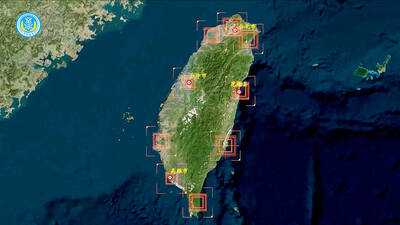At face value, Foret Debussy is a stunningly shot Taiwanese version of Survivor, featuring mother-and-daughter duo Lu Yi-ching (陸弈靜) and Gwei Lun-mei (桂綸鎂), who are hiding deep in the forest due to a terrible tragedy that tortures them constantly.
Despite the backstory and despair-filled atmosphere, most of the actual sequences focus on them trying to survive and the hardships they face — from trying to fashion a canopy to shelter from the rain to fishing with hand-made rods to ingesting poison berries.
This is the first full-length feature by director Kuo Cheng-chui (郭承衢), who also cast Lu and Gwei as a mother and daughter eight years ago in his short film Family Viewing (闔家觀賞). Kuo calls Foret Debussy a “phytoncide film,” and green is indeed all you will see throughout. The title alludes to how composer Claude Debussy was deeply inspired by nature, and as you can image, his music features prominently in the film.

Photo courtesy of Warner Bros
Gwei plays the wan, silent and tortured persona perfectly, languishing in the past as her mother tries to keep them alive despite her own grief, which does erupt in bursts. The dialogue is sparse, but every sentence counts — we basically find out what happened through aural flashbacks and the few sentences exchanged between the two.
Here’s an example: “Did you ever think about the consequences?” Lu asks Gwei while she tries to unsuccessfully light a fire. After a very long pause, Gwei replies calmly, “You would have done the same.” Then they carry on with their tasks in silence, and finally Lu walks away.
This is a testament to the acting skills of the two protagonists as their sorrow, their complicated feelings toward each other and the suffocating tension surrounding them remain clear and powerful even though nothing significant is actually happening in the film. The otherworldly environment and surrealness of the whole situation also adds to the intrigue.
There also seems to be an environmental protection theme behind the film, but is only directly alluded to in two sequences. Perhaps showing the fact that there are still such pristine and untouched landscapes in Taiwan is enough.
Unfortunately, the story stops halfway through the film. There are no more flashbacks, or any dialogue at all for that matter, as it becomes sort of a vehicle for Gwei to show off her acting chops (which will probably win her some acting awards) and the production team to flaunt their brilliant visuals. It meanders on and on, and all the tension and intrigue that made the first half interesting turns into pure anguish and desperation, and one starts to wonder what is the point of the film and where it is going.
At first, the camera sequences work beautifully with the lush scenery, using a mix of static shots, wide pans and hand-held camera closeups while playing with depth of field to create compelling moods and effects. A memorable sequence takes place when Gwei’s character reminisces of a past conversation while standing with her face very close to a tree. The camera zooms in on her face, then circles the tree in an extreme close-up fashion where we can clearly see the moss, bark and leaves and slowly returns to Gwei’s face from the other side as the memory concludes.
But that was when there was still a story. As the film moves on and the story completely stops, these techniques become vanity flourishes as they lose their connotation. Soon, the endless greenery turns claustrophobic — which is probably the director’s intent, but it could have been handled in a more eventful way. While it is an arthouse film, the way the story is revealed in the first half already departs from the norm enough while still being entertaining. Sometimes you don’t have to go further than that.

April 7 to April 13 After spending over two years with the Republic of China (ROC) Army, A-Mei (阿美) boarded a ship in April 1947 bound for Taiwan. But instead of walking on board with his comrades, his roughly 5-tonne body was lifted using a cargo net. He wasn’t the only elephant; A-Lan (阿蘭) and A-Pei (阿沛) were also on board. The trio had been through hell since they’d been captured by the Japanese Army in Myanmar to transport supplies during World War II. The pachyderms were seized by the ROC New 1st Army’s 30th Division in January 1945, serving

The People’s Republic of China (PRC) last week offered us a glimpse of the violence it plans against Taiwan, with two days of blockade drills conducted around the nation and live-fire exercises not far away in the East China Sea. The PRC said it had practiced hitting “simulated targets of key ports and energy facilities.” Taiwan confirmed on Thursday that PRC Coast Guard ships were directed by the its Eastern Theater Command, meaning that they are assumed to be military assets in a confrontation. Because of this, the number of assets available to the PRC navy is far, far bigger

The 1990s were a turbulent time for the Chinese Nationalist Party’s (KMT) patronage factions. For a look at how they formed, check out the March 2 “Deep Dives.” In the boom years of the 1980s and 1990s the factions amassed fortunes from corruption, access to the levers of local government and prime access to property. They also moved into industries like construction and the gravel business, devastating river ecosystems while the governments they controlled looked the other way. By this period, the factions had largely carved out geographical feifdoms in the local jurisdictions the national KMT restrained them to. For example,

The remains of this Japanese-era trail designed to protect the camphor industry make for a scenic day-hike, a fascinating overnight hike or a challenging multi-day adventure Maolin District (茂林) in Kaohsiung is well known for beautiful roadside scenery, waterfalls, the annual butterfly migration and indigenous culture. A lesser known but worthwhile destination here lies along the very top of the valley: the Liugui Security Path (六龜警備道). This relic of the Japanese era once isolated the Maolin valley from the outside world but now serves to draw tourists in. The path originally ran for about 50km, but not all of this trail is still easily walkable. The nicest section for a simple day hike is the heavily trafficked southern section above Maolin and Wanshan (萬山) villages. Remains of